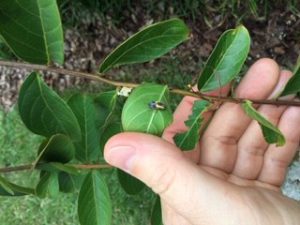 Join us in celebrating 30 years of Florida-Florida Friendly Landscaping™ this blog series. Since 1993, Florida-Friendly Landscaping™ has served as the state of Florida’s premier Extension program that promotes sustainable alternatives to “conventional” landscaping, providing guidance on low impact, environmentally friendly, science-based landscape practices that use less water and reduce pollutant loading to Florida waters. In this series, you will learn:
Join us in celebrating 30 years of Florida-Florida Friendly Landscaping™ this blog series. Since 1993, Florida-Friendly Landscaping™ has served as the state of Florida’s premier Extension program that promotes sustainable alternatives to “conventional” landscaping, providing guidance on low impact, environmentally friendly, science-based landscape practices that use less water and reduce pollutant loading to Florida waters. In this series, you will learn:
1. Five FFL Facts to Know to Help you Grow
2. What’s the Word? Five FFL Terms to Know
3. Take Some Action in Five Simple Steps!
4. Five Steps to Become a Florida Friendly Landscaper
5. Five Ways to Know You are a Florida-Friendly Follower
In moving towards landscaping more sustainably the Florida-Friendly way, it helps to understand the “what and “why” of some terms and phrases that may be unfamiliar. Here are five, and the FFL principles that addresses the “how”:
- Watershed:
A watershed is an area of land that water flows across as it moves toward streams, rivers, lakes or coastal waters. This means we pretty much ALL live on watersheds. Practicing water conservation on our properties and in our landscapes reduces pollution to Florida’s water sources. (FFL principles #8, and 9) - Stormwater runoff:
Stormwater runoff occurs after a rainfall and is one of Florida’s greatest threats to clean water resources. As water flows over the impervious surfaces of driveways, sidewalks and roadways, it is unable to seep into the soil and filter slowly into our underground aquifers. This waterflow picks up polluting materials such as fertilizers, pesticides and others as they make their way to our water resources. If you live in a typical urban area, you can watch water pass through your street and into your local storm drainage system. (FFL principles #2, and 8)
- Good bugs/bad bugs:
This is a phrase used to describe insects in gardens and landscapes, but what does it mean? In natural settings, all insects (bugs) are part of an elaborate and interconnected system in which they work together and form a natural ecosystem. There is no good or bad bug in nature (apart from introduced invasive types, but that’s another story). In horticulture, however, there are insects that are detrimental to the growth and health of desired plants. In our gardens and landscapes, insects can be described as: bad (harming our desired plants, such as thrips); or good (aiding in managing harmful bugs and/or contributing to the environment, such as pollinators). Killing all insects on your property is unnecessary and inefficient. Don’t be too quick to reach for that pesticide! (FFL principle #6) - Volcano mulching:
What in the world is “volcano mulching”? FFL teaches the benefits of using organic mulches in our landscapes, but how you use mulch is critical to the health of your plants. While organic mulching is recommended at a proper depth of 2-4”, for some reason a highly detrimental mulching practice has evolved, especially on our trees. This method involves piling a much deeper height of mulch around the trunks of trees, and is called volcano mulching, a term that suggests the appearance of the tree trunk emerging from a volcano-shaped mulch pile. It is difficult to understand how this harmful practice began; perhaps the thought that if mulch is good, more mulch is better. In fact, it is harmful to trees in many ways and can lead to the decline and even death of a tree. Regrettably volcano mulching is seen in so many landscapes, even on our public roadside tree plantings, it would appear to be an acceptable practice. Read up on volcano mulching and avoid this harmful method! (FFL principle #4) - Nonpoint pollution:
Pollution sources are often described as point pollution (pollution that is produced by known targeted sources such as industrial pipes, or wastewater treatment plants). Nonpoint pollution does not come from a specific source. Instead, it originates from many places or from a widespread area. The overall goal of Florida-Friendly Landscaping™ is to reduce nonpoint pollution through teaching more sustainable landscape practices. (All of FFL principles – #1-9)
Together, we have a great opportunity to learn how to create beautiful and healthy landscapes that can be a powerful source of good to Florida’s environment
For more information, contact UF/IFAS Extension Polk County at (863) 519-1041 or visit us online at http://sfyl.ifas.ufl.edu/polk. The Plant Clinic is open Monday-Friday, 9:00 am-4:00 pm to answer your gardening and landscaping questions. Give us a call or email us at polkmg@ifas.ufl.edu.
If you are not in Polk County, Contact your local UF/IFAS Extension Master Gardener Volunteer Plant Clinic.
The Florida Master Gardener Volunteer Program is a volunteer-driven program that benefits UF/IFAS Extension and the citizens of Florida. The program extends the vision of the University of Florida/Institute of Food and Agricultural Sciences, all the while protecting and sustaining natural resources and environmental systems, enhancing the development of human resources, and improving the quality of human life through the development of knowledge in agricultural, human and natural resources and making that knowledge accessible.
An Equal Opportunity Institution.
 2
2

